The Story of Mona Lisa
| Mona Lisa | |
|---|---|
| Italian: Monna Lisa, Italian: La Gioconda | |
 | |
| Artist | Leonardo da Vinci |
| Year | c. 1503–1506, perhaps continuing until c. 1517 |
| Medium | Oil on poplar panel |
| Subject | Lisa Gherardini |
| Dimensions | 77 cm × 53 cm (30 in × 21 in) |
| Location | The Louvre Museum, Paris |
The Mona Lisa (/ˌmoʊnə
The painting is thought by many to be a portrait of Lisa Gherardini,[4] the wife of Francesco del Giocondo, and is in oil on a white Lombardy poplar panel. It had been believed to have been painted between 1503 and 1506; however, Leonardo may have continued working on it as late as 1517. Recent academic work suggests that it would not have been started before 1513.[5][6][7][8] It was acquired by King Francis I of Franceand is now the property of the French Republic, on permanent display at the Louvre Museum in Paris since 1797.[9]
The subject's expression, which is frequently described as enigmatic,[10] the monumentality of the composition, the subtle modelling of forms, and the atmospheric illusionism were novel qualities that have contributed to the continuing fascination and study of the work.[11]
The title of the painting, which is known in English as Mona Lisa, comes from a description by Renaissance art historian Giorgio Vasari, who wrote "Leonardo undertook to paint, for Francesco del Giocondo, the portrait of Mona Lisa, his wife."[12][13] Mona in Italian is a polite form of address originating as "ma donna" – similar to "Ma'am", "Madam", or "my lady" in English. This became "madonna", and its contraction "mona". The title of the painting, though traditionally spelled "Mona" (as used by Vasari[12]), is also commonly spelled in modern Italian as Monna Lisa ("mona" being a vulgarity in some Italian dialects), but this is rare in English.[citation needed]
Vasari's account of the Mona Lisa comes from his biography of Leonardo published in 1550, 31 years after the artist's death. It has long been the best-known source of information on the provenance of the work and identity of the sitter. Leonardo's assistant Salaì, at his death in 1524, owned a portrait which in his personal papers was named la Gioconda, a painting bequeathed to him by Leonardo.
That Leonardo painted such a work, and its date, were confirmed in 2005 when a scholar at Heidelberg University discovered a marginal note in a 1477 printing of a volume by ancient Roman philosopher Cicero. Dated October 1503, the note was written by Leonardo's contemporary Agostino Vespucci. This note likens Leonardo to renowned Greek painter Apelles, who is mentioned in the text, and states that Leonardo was at that time working on a painting of Lisa del Giocondo.[14]
In response to the announcement of the discovery of this document, Vincent Delieuvin, the Louvre representative, stated "Leonardo da Vinci was painting, in 1503, the portrait of a Florentine lady by the name of Lisa del Giocondo. About this we are now certain. Unfortunately, we cannot be absolutely certain that this portrait of Lisa del Giocondo is the painting of the Louvre."[15]
The model, Lisa del Giocondo,[16][17] was a member of the Gherardini family of Florence and Tuscany, and the wife of wealthy Florentine silk merchant Francesco del Giocondo.[18] The painting is thought to have been commissioned for their new home, and to celebrate the birth of their second son, Andrea.[19] The Italian name for the painting, La Gioconda, means "jocund" ("happy" or "jovial") or, literally, "the jocund one", a pun on the feminine form of Lisa's married name, "Giocondo".[18][20] In French, the title La Joconde has the same meaning.
Before that discovery, scholars had developed several alternative views as to the subject of the painting. Some argued that Lisa del Giocondo was the subject of a different portrait, identifying at least four other paintings as the Mona Lisa referred to by Vasari.[21][22] Several other women have been proposed as the subject of the painting.[23] Isabella of Aragon,[24] Cecilia Gallerani,[25] Costanza d'Avalos, Duchess of Francavilla,[23] Isabella d'Este, Pacifica Brandano or Brandino, Isabela Gualanda, Caterina Sforza—even Salaì and Leonardo himself—are all among the list of posited models portrayed in the painting.[26][27] The consensus of art historians in the 21st century maintains the long-held traditional opinion that the painting depicts Lisa del Giocondo.[14]
History
Leonardo da Vinci had begun working on a portrait of Lisa del Giocondo, the model of the Mona Lisa, by October 1503.[28][15] It is believed by some that the Mona Lisa was begun in 1503 or 1504 in Florence.[29] Although the Louvre states that it was "doubtless painted between 1503 and 1506",[11] art historian Martin Kemp says that there are some difficulties in confirming the dates with certainty.[18] In addition, many Leonardo experts, such as Carlo Pedretti and Alessandro Vezzosi, are of the opinion that the painting is characteristic of Leonardo's style in the final years of his life, post-1513.[5][6] Other academics argue that, given the historical documentation, Leonardo would have painted the work from 1513.[8] According to Giorgio Vasari, "after he had lingered over it four years, [he] left it unfinished".[13] In 1516, Leonardo was invited by King Francis I to work at the Clos Lucé near the Château d'Amboise; it is believed that he took the Mona Lisa with him and continued to work on it after he moved to France.[26] Art historian Carmen C. Bambach has concluded that Leonardo probably continued refining the work until 1516 or 1517.[30] Leonardo's right hand was paralytic circa 1517,[31] which may indicate why he left the Mona Lisaunfinished.[32][33][34][a]
Circa 1504, Raphael executed a pen-and-ink sketch, in which the subject is flanked by large columns. Experts universally agree that it is based on Leonardo's portrait.[36][7][37] Other later copies of the Mona Lisa, such as those in the National Museum of Art, Architecture and Design and The Walters Art Museum, also display large flanking columns. As a result, it was thought that the Mona Lisa had once had side columns and been trimmed.[38][39][5][40][41] However, by 1993, Frank Zöllnerobserved that the painting surface had never been trimmed;[42] this was confirmed through a series of tests in 2004.[43] In view of this, Vincent Delieuvin, curator of 16th-century Italian painting at the Louvre, states that the sketch and these other copies must have been inspired by another version,[44] while Zöllner states that the sketch may be after another Leonardo portrait of the same subject.[42][b]
According to Vasari, the painting was painted for the model's husband, Francesco del Giocondo.[45]However, following a visit with Leonardo in 1517, Antonio de Beatis recorded that it was executed for Leonardo's steward at the Belvedere Palace between 1513 and 1516, Giuliano de' Medici (d. 1516).[46][47] A number of experts have argued that Leonardo made two versions of the portrait (because of the conflicting dating, the presence of flanking columns in Raphael's sketch, and the uncertainty concerning its commissioner—as well as its fate following Leonardo's death in 1519).[37][7][48] The first, containing flanking columns, would have been commissioned by Giocondo circa 1503, and left unfinished in Leonardo's pupil and assistant Salaì's possession until his death in 1524. The second, commissioned by Giuliano de' Medici circa 1513, would have been sold by Salaì to Francis I in 1518[c] and is the one in the Louvre today.[37][7][48][49] Other believe that there was only one Mona Lisa, but are divided as to the two aforementioned fates.[18][50][51]It was kept at the Palace of Fontainebleau, where it remained until Louis XIV moved it to the Palace of Versailles, where it remained until the French Revolution.[citation needed] In 1797, it went on permanent display at the Louvre.[9]
In the early 21st century, French scientist Pascal Cotte hypothesized a hidden portrait underneath the surface of the painting, circumstantial evidence for which was produced using reflective light technology.[52][53] The underlying portrait appears to be of a model looking to the side, but lacks the flanking columns drawn by Raphael.[54] Having been given access to the painting by the Louvre in 2004, Cotte spent ten years studying the painting with layer-amplification methods.[52][55] However, the alleged portrait does not fit with historical descriptions of the painting: both Vasari and Gian Paolo Lomazzo describe the subject as smiling,[12][56] unlike the subject in Cotte's portrait. Cotte admits that his reconstitution had been carried out only in support of his hypotheses and should not be considered as objective proof of an underlying portrait.[53][50]
Refuge, theft and vandalism
After the French Revolution, the painting was moved to the Louvre, but spent a brief period in the bedroom of Napoleon (d. 1821) in the Tuileries Palace.[citation needed] The Mona Lisa was not widely known outside the art world, but in the 1860s, a portion of the French intelligentsia began to hail it as a masterwork of Renaissance painting.[57] During the Franco-Prussian War (1870–1871), the painting was moved from the Louvre to the Brest Arsenal.[58] During World War II, it was again removed from the Louvre and taken first to the Château d'Amboise, then to the Loc-Dieu Abbey and Château de Chambord, then finally to the Ingres Museum in Montauban. By 1911, the painting was still not popular among the lay-public.[59]
On 21 August 1911, the painting was stolen from the Louvre.[60] The missing painting was first noticed the next day by painter Louis Béroud. After some confusion as to whether the painting was being photographed somewhere, the Louvre was closed for a week for investigation. French poet Guillaume Apollinaire came under suspicion and was arrested and imprisoned. Apollinaire implicated his friend Pablo Picasso, who was brought in for questioning. Both were later exonerated.[61][62] The real culprit was Louvre employee Vincenzo Peruggia, who had helped construct the painting's glass case.[63] He carried out the theft by entering the building during regular hours, hiding in a broom closet, and walking out with the painting hidden under his coat after the museum had closed.[20]
Peruggia was an Italian patriot who believed that Leonardo's painting should have been returned to an Italian museum. Peruggia may have been motivated by an associate whose copies of the original would significantly rise in value after the painting's theft.[64] After having kept the Mona Lisa in his apartment for two years, Peruggia grew impatient and was caught when he attempted to sell it to directors of the Uffizi Gallery in Florence. It was exhibited in the Uffizi Gallery for over two weeks and returned to the Louvre on 4 January 1914.[65] Peruggia served six months in prison for the crime and was hailed for his patriotism in Italy.[62] A year after the theft, Saturday Evening Post journalist Karl Decker met an alleged accomplice named Eduardo de Valfierno, who claimed to have masterminded the theft. Forger Yves Chaudron was to have created six copies of the painting to sell in the US while concealing the location of the original.[64] Decker published this account of the theft in 1932.[66]
On 30 December 1956, a rock was thrown at the painting in the Louvre, shattering its glass case and dislodging a speck of pigment near the left elbow, which was later restored.[67] The painting was protected by glass because a few years earlier a man who claimed to be in love with the painting had cut it with a razor blade and tried to steal it.[68] The use of bulletproof glass has shielded the Mona Lisa from subsequent attacks. In April 1974, while the painting was on display at the Tokyo National Museum, a woman sprayed it with red paint as a protest against that museum's failure to provide access for disabled people.[69] On 2 August 2009, a Russian woman, distraught over being denied French citizenship, threw a ceramic teacup purchased at the Louvre; the vessel shattered against the glass enclosure.[70][71] In both cases, the painting was undamaged.
In recent decades, the painting has been temporarily moved to accommodate renovations to the Louvre on three occasions: between 1992 and 1995, from 2001 to 2005, and again in 2019.[72]
Aesthetics
The Mona Lisa bears a strong resemblance to many Renaissance depictions of the Virgin Mary, who was at that time seen as an ideal for womanhood.[73]
The depiction of the sitter in three-quarter profile is similar to late 15th-century works by Lorenzo di Crediand Agnolo di Domenico del Mazziere.[73] Zöllner notes that the sitter's general position can be traced back to Flemish models and that "in particular the vertical slices of columns at both sides of the panel had precedents in Flemish portraiture."[74] Woods-Marsden cites Hans Memling's portrait of Benedetto Portinari(1487) or Italian imitations such as Sebastiano Mainardi's pendant portraits for the use of a loggia, which has the effect of mediating between the sitter and the distant landscape, a feature missing from Leonardo's earlier portrait of Ginevra de' Benci.[75]
The woman sits markedly upright in a "pozzetto" armchair with her arms folded, a sign of her reserved posture. Her gaze is fixed on the observer. The woman appears alive to an unusual extent, which Leonardo achieved by his method of not drawing outlines (sfumato). The soft blending creates an ambiguous mood "mainly in two features: the corners of the mouth, and the corners of the eyes".[76]
The painting was one of the first portraits to depict the sitter in front of an imaginary landscape, and Leonardo was one of the first painters to use aerial perspective.[78]The enigmatic woman is portrayed seated in what appears to be an open loggia with dark pillar bases on either side. Behind her, a vast landscape recedes to icy mountains. Winding paths and a distant bridge give only the slightest indications of human presence. Leonardo has chosen to place the horizon line not at the neck, as he did with Ginevra de' Benci, but on a level with the eyes, thus linking the figure with the landscape and emphasizing the mysterious nature of the painting.[75]
Mona Lisa has no clearly visible eyebrows or eyelashes. Some researchers claim that it was common at this time for genteel women to pluck these hairs, as they were considered unsightly.[79][80] In 2007, French engineer Pascal Cotte announced that his ultra-high resolution scans of the painting provide evidence that Mona Lisa was originally painted with eyelashes and with visible eyebrows, but that these had gradually disappeared over time, perhaps as a result of overcleaning.[81] Cotte discovered the painting had been reworked several times, with changes made to the size of the Mona Lisa's face and the direction of her gaze. He also found that in one layer the subject was depicted wearing numerous hairpins and a headdress adorned with pearls which was later scrubbed out and overpainted.[82]
There has been much speculation regarding the painting's model and landscape. For example, Leonardo probably painted his model faithfully since her beauty is not seen as being among the best, "even when measured by late quattrocento (15th century) or even twenty-first century standards."[83] Some art historians in Eastern art, such as Yukio Yashiro, argue that the landscape in the background of the picture was influenced by Chinese paintings,[84] but this thesis has been contested for lack of clear evidence.[84]
Research in 2003 by Professor Margaret Livingstone of Harvard University said that Mona Lisa's smile disappears when observed with direct vision, known as foveal. Because of the way the human eye processes visual information, it is less suited to pick up shadows directly; however, peripheral vision can pick up shadows well.[85]
Research in 2008 by a geomorphology professor at Urbino University and an artist-photographer revealed likenesses of Mona Lisa's landscapes to some views in the Montefeltro region in the Italian provinces of Pesaro and Urbino, and Rimini.[86][87]
Conservation
The Mona Lisa has survived for more than 500 years, and an international commission convened in 1952 noted that "the picture is in a remarkable state of preservation."[43] This is partly due to a variety of conservation treatments the painting has undergone. A detailed analysis in 1933 by Madame de Gironde revealed that earlier restorers had "acted with a great deal of restraint."[43] Nevertheless, applications of varnish made to the painting had darkened even by the end of the 16th century, and an aggressive 1809 cleaning and revarnishing removed some of the uppermost portion of the paint layer, resulting in a washed-out appearance to the face of the figure. Despite the treatments, the Mona Lisa has been well cared for throughout its history, and although the panel's warping caused the curators "some worry",[88] the 2004–05 conservation team was optimistic about the future of the work.[43]
Poplar panel
At some point, the Mona Lisa was removed from its original frame. The unconstrained poplar panel warped freely with changes in humidity, and as a result, a crack developed near the top of the panel, extending down to the hairline of the figure. In the mid-18th century to early 19th century, two butterfly-shaped walnut braces were inserted into the back of the panel to a depth of about one third the thickness of the panel. This intervention was skilfully executed, and successfully stabilized the crack. Sometime between 1888 and 1905, or perhaps during the picture's theft, the upper brace fell out. A later restorer glued and lined the resulting socket and crack with cloth.[citation needed]
The picture is kept under strict, climate-controlled conditions in its bulletproof glass case. The humidity is maintained at 50% ±10%, and the temperature is maintained between 18 and 21 °C. To compensate for fluctuations in relative humidity, the case is supplemented with a bed of silica gel treated to provide 55% relative humidity.[43]
Frame
Because the Mona Lisa's poplar support expands and contracts with changes in humidity, the picture has experienced some warping. In response to warping and swelling experienced during its storage during World War II, and to prepare the picture for an exhibit to honour the anniversary of Leonardo's 500th birthday, the Mona Lisa was fitted in 1951 with a flexible oak frame with beech crosspieces. This flexible frame, which is used in addition to the decorative frame described below, exerts pressure on the panel to keep it from warping further. In 1970, the beech crosspieces were switched to maple after it was found that the beechwood had been infested with insects. In 2004–05, a conservation and study team replaced the maple crosspieces with sycamore ones, and an additional metal crosspiece was added for scientific measurement of the panel's warp.[citation needed]
The Mona Lisa has had many different decorative frames in its history, owing to changes in taste over the centuries. In 1909, the art collector Comtesse de Béhague gave the portrait its current frame,[89] a Renaissance-era work consistent with the historical period of the Mona Lisa. The edges of the painting have been trimmed at least once in its history to fit the picture into various frames, but no part of the original paint layer has been trimmed.[43]
Cleaning and touch-up
The first and most extensive recorded cleaning, revarnishing, and touch-up of the Mona Lisa was an 1809 wash and revarnishing undertaken by Jean-Marie Hooghstoel, who was responsible for restoration of paintings for the galleries of the Musée Napoléon. The work involved cleaning with spirits, touch-up of colour, and revarnishing the painting. In 1906, Louvre restorer Eugène Denizard performed watercolour retouches on areas of the paint layer disturbed by the crack in the panel. Denizard also retouched the edges of the picture with varnish, to mask areas that had been covered initially by an older frame. In 1913, when the painting was recovered after its theft, Denizard was again called upon to work on the Mona Lisa. Denizard was directed to clean the picture without solvent, and to lightly touch up several scratches to the painting with watercolour. In 1952, the varnish layer over the background in the painting was evened out. After the second 1956 attack, restorer Jean-Gabriel Goulinat was directed to touch up the damage to Mona Lisa's left elbow with watercolour.[43]
In 1977, a new insect infestation was discovered in the back of the panel as a result of crosspieces installed to keep the painting from warping. This was treated on the spot with carbon tetrachloride, and later with an ethylene oxide treatment. In 1985, the spot was again treated with carbon tetrachloride as a preventive measure.[43]
Display
On 6 April 2005—following a period of curatorial maintenance, recording, and analysis—the painting was moved to a new location within the museum's Salle des États. It is displayed in a purpose-built, climate-controlled enclosure behind bulletproof glass.[90] Since 2005 the painting has been illuminated by an LED lamp, and in 2013 a new 20 watt LED lamp was installed, specially designed for this painting. The lamp has a Colour Rendering Index up to 98, and minimizes infraredand ultraviolet radiation which could otherwise degrade the painting.[91] The renovation of the gallery where the painting now resides was financed by the Japanese broadcaster Nippon Television.[92] About 6 million people view the painting at the Louvre each year.[26]
Fame
Today the Mona Lisa is considered the most famous painting in the world, but until the 20th century it was simply one among many highly regarded artworks.[93] Once part of King Francis I of France's collection, the Mona Lisa was among the first artworks to be exhibited in the Louvre, which became a national museum after the French Revolution. Leonardo began to be revered as a genius, and the painting's popularity grew in the mid-19th century when French intelligentsia praised it as mysterious and a representation of the femme fatale.[94] The Baedeker guide in 1878 called it "the most celebrated work of Leonardo in the Louvre",[95] but the painting was known more by the intelligentsia than the general public.[citation needed]
The 1911 theft of the Mona Lisa and its subsequent return was reported worldwide, leading to a massive increase in public recognition of the painting. During the 20th century it was an object for mass reproduction, merchandising, lampooning and speculation, and was claimed to have been reproduced in "300 paintings and 2,000 advertisements".[95] The Mona Lisa was regarded as "just another Leonardo until early last century, when the scandal of the painting's theft from the Louvre and subsequent return kept a spotlight on it over several years."[96]
From December 1962 to March 1963, the French government lent it to the United States to be displayed in New York City and Washington, D.C.[97][98] It was shipped on the new ocean liner SS France.[99] In New York, an estimated 1.7 million people queued "in order to cast a glance at the Mona Lisa for 20 seconds or so."[95] While exhibited in the Metropolitan Museum of Art, the painting was nearly drenched in water because of a faulty sprinkler, but the painting's bullet-proof glass case protected it.[100]
In 1974, the painting was exhibited in Tokyo and Moscow.[101]
In 2014, 9.3 million people visited the Louvre.[102] Former director Henri Loyrette reckoned that "80 percent of the people only want to see the Mona Lisa."[103]
Financial worth
Before the 1962–1963 tour, the painting was assessed for insurance at $100 million (equivalent to $650 million in 2018), making it, in practice, the most valued painting in the world. The insurance was not purchased; instead, more was spent on security.[104]
In 2014, a France 24 article suggested that the painting could be sold to help ease the national debt, although it was noted that the Mona Lisa and other such art works were prohibited from being sold due to French heritage law, which states that "Collections held in museums that belong to public bodies are considered public property and cannot be otherwise."[105]
Legacy
The Mona Lisa began influencing contemporary Florentine painting even before its completion. Raphael, who had been to Leonardo's workshop several times, promptly used elements of the portrait's composition and format in several of his works, such as Young Woman with Unicorn (c. 1506[106]), and Portrait of Maddalena Doni(c. 1506). Later paintings by Raphael, such as La velata (1515–16) and Portrait of Baldassare Castiglione (c. 1514–15), continued to borrow from Leonardo's painting. Zollner states that "None of Leonardo's works would exert more influence upon the evolution of the genre than the Mona Lisa. It became the definitive example of the Renaissance portrait and perhaps for this reason is seen not just as the likeness of a real person, but also as the embodiment of an ideal."[107]
Early commentators such as Vasari and André Félibien praised the picture for its realism, but by the Victorian era, writers began to regard the Mona Lisa as imbued with a sense of mystery and romance. In 1859, Théophile Gautier wrote that the Mona Lisa was a "sphinx of beauty who smiles so mysteriously" and that "Beneath the form expressed one feels a thought that is vague, infinite, inexpressible. One is moved, troubled ... repressed desires, hopes that drive one to despair, stir painfully." Walter Pater's famous essay of 1869 described the sitter as "older than the rocks among which she sits; like the vampire, she has been dead many times, and learned the secrets of the grave; and has been a diver in the deep seas, and keeps their fallen day about her."[108]
By the early 20th century, some critics started to feel the painting had become a repository for subjective exegeses and theories.[109] Upon the painting's theft in 1911, Renaissance historian Bernard Berensonadmitted that it had "simply become an incubus, and [he] was glad to be rid of her."[109][110] Jean Metzinger's Le goûter (Tea Time) was exhibited at the 1911 Salon d'Automne and was sarcastically described as "la Joconde à la cuiller" (Mona Lisa with a spoon) by art critic Louis Vauxcelles on the front page of Gil Blas.[111]André Salmon subsequently described the painting as "The Mona Lisa of Cubism".[112][113][114]
The avant-garde art world has made note of the Mona Lisa's undeniable popularity. Because of the painting's overwhelming stature, Dadaists and Surrealists often produce modifications and caricatures. In 1883, Le rire, an image of a Mona Lisa smoking a pipe, by Sapeck (Eugène Bataille), was shown at the "Incoherents" show in Paris. In 1919, Marcel Duchamp, one of the most influential modern artists, created L.H.O.O.Q., a Mona Lisa parody made by adorning a cheap reproduction with a moustache and goatee. Duchamp added an inscription, which when read out loud in French sounds like "Elle a chaud au cul" meaning: "she has a hot ass", implying the woman in the painting is in a state of sexual excitement and intended as a Freudian joke.[115] According to Rhonda R. Shearer, the apparent reproduction is in fact a copy partly modelled on Duchamp's own face.[116]
Salvador Dalí, famous for his surrealist work, painted Self portrait as Mona Lisa in 1954.[117] Andy Warhol created serigraph prints of multiple Mona Lisas, called Thirty are Better than One, following the painting's visit to the United States in 1963.[118] The French urban artist known pseudonymously as Invader has created versions of the Mona Lisa on city walls in Paris and Tokyo using a mosaic style.[119] A 2014 New Yorker magazine cartoon parodies the supposed enigma of the Mona Lisasmile in an animation showing progressively more maniacal smiles.
Early versions and copies
Prado Museum La Gioconda
A version of Mona Lisa known as Mujer de mano de Leonardo Abince ("Woman by Leonardo da Vinci's hand") held in Madrid's Museo del Prado was for centuries considered to be a work by Leonardo. However, since its restoration in 2012 it is considered to have been executed by one of Leonardo's pupils in his studio at the same time as Mona Lisa was being painted.[120] The Prado's conclusion that that the painting is probably by Salaì (1480–1524) or by Melzi (1493–1572) has been called into question by others.[121]
The restored painting is from a slightly different perspective than the original Mona Lisa, leading to the speculation that it is part of the world's first stereoscopic pair.[122][123][124] However, a more recent report has demonstrated that this stereoscopic pair in fact gives no reliable stereoscopic depth.[125]
Isleworth Mona Lisa
A version of the Mona Lisa known as the Isleworth Mona Lisa and also known as the Earlier Mona Lisa was first bought by an English nobleman in 1778 and was rediscovered in 1913 by Hugh Blaker, an art connoisseur. The painting was presented to the media in 2012 by the Mona Lisa Foundation.[126] It is a painting of the same subject as Leonardo da Vinci's Mona Lisa. The painting is claimed by a majority of experts to be mostly an original work of Leonardo dating from the early 16th century.[7][8][37][48] Other experts, including Zöllner and Kemp, deny the attribution.[127][128]




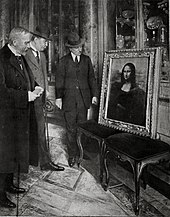

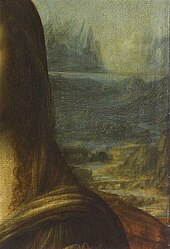
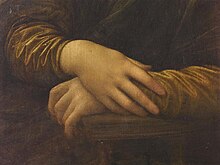


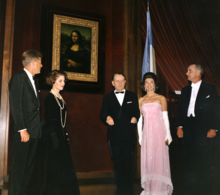



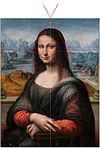


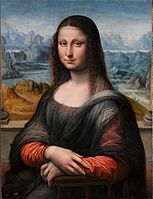

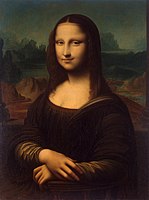
Comments
Post a Comment